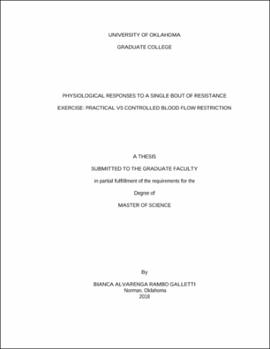| dc.description.abstract | Blood flow restriction (BFR) exercise has been used to induce increases in muscle size and strength at relatively low exercise intensities. The technique requires the application of a restriction device to reduce blood flow to the exercising limb, which causes unique physiological responses. The technique can be done using an inflatable cuff or knee wraps. However, people are more likely to use the knee wraps compared to the inflatable cuffs on daily basis. PURPOSE: The aim of this study was to compare the effects of a single bout of practical blood flow restriction, controlled blood flow restriction, high intensity, and low-intensity with no blood flow restriction resistance exercise on muscle activation, muscle swelling, and lactate responses in college-aged females. Most studies have examined metabolic responses to BFR separately, and to our knowledge, no one has examined the issue of limb symmetry following controlled and practical implementation of blood flow restriction. METHODS: Fifteen recreationally active females (20.3 ± 1.6 years old) were recruited for this research. The participants performed 4 different exercising protocols in a random order: 1) low intensity with controlled blood flow restriction (cBFR): pressure set at 50% of total occlusion pressure, intensity set at 30% of 1RM, and 4 sets of 30-15-15-15 repetitions; 2) Practical blood flow restriction exercise (pBFR): pressure set at 7 based on a perceived pressure scale of 0 (no pressure, no pain) to 10 (extreme pressure with pain), intensity set at 30% of 1RM, and 4 sets of 30-15-15-15 repetitions; 3) High intensity (HI): intensity set at 80% of 1RM, with 3 sets of 10 repetitions, without any blood flow restriction; 4) Control (CON): intensity set at 30% of 1RM, 4 sets of 30-15-15-15 repetitions, without any blood flow restriction. Subjects had muscle thickness, thigh circumference, muscle activation
xii
(Electromyography [EMG]), blood lactate, and hematocrit assessed at rest, immediately post-exercise, and 5 and 15 min post-exercise. Strength was assessed using one maximum repetition (1RM) test for leg-press and knee extension. RESULTS: Muscle swelling significantly increased from pre-exercise measures to 15 post for all conditions, as represented by thigh circumference (p ≤ 0.05) and muscle thickness (p ≤ 0.05). Hematocrit decreased from pre-exercise to 15P (p ≤ 0.05) and percent of plasma volume changes (%PVC) increased from IP to 15P (p ≤ 0.05). No differences between conditions were reported among the variables associated to muscle swelling (p ≥ 0.05). Lactate increased over time for all testing conditions (p ≤ 0.05), with HI having higher levels than cBFR, and cBFR being higher than pBFR and LI (p ≤ 0.05). Muscle activation also significantly changed across time for all conditions with both exercises (p ≤ 0.05), where HI showed greater muscle activation than cBFR, and cBFR greater than pBFR and LI (p ≤ 0.05). CONCLUSION: Muscle swelling seems to increase overtime to a similar extent for HI, cBFR, pBFR, and LI. Increases in thigh circumference and muscle thickness were highly correlated between legs, demonstrating no asymmetrical responses. However, lactate and muscle activation demonstrated greater responses for HI and cBFR than pBFR and LI, leading to the conclusion that cBFR might induce greater muscular stress than pBFR, which can possibly promote larger adaptations. | en_US |
